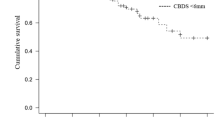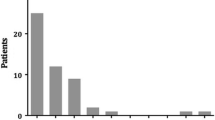Abstract
Background
Although the endoscopic management of bile leaks after cholecystectomy (CCY) is well established, the yield of a routine endoscopic retrograde cholangiogram (ERC) with a bile duct sweep at the time of stent removal is unclear. This study aimed to describe the prevalence of abnormal findings at follow-up ERC to determine whether upper endoscopy with stent removal and without cholangiography would suffice.
Methods
A retrospective cohort analysis of all patients referred for initial and follow-up ERC with post-CCY bile leak was performed. The rate of abnormal findings was measured including choledocholithiasis, biliary strictures, and persistent bile leaks at follow-up ERC. Secondarily, the study sought to define the clinical characteristics of patients who demonstrated stones or sludge at follow-up assessment.
Results
Between January, 2003 and April, 2008, 105 patients underwent initial and follow-up ERC. After a mean interval of 6.9 ± 2.7 weeks between endoscopies, 29 (27.6%) of the 105 patients demonstrated one or more abnormalities including persistent bile leak (n = 8), common bile duct (CBD) stones (n = 12), and CBD sludge alone (n = 9). In the subgroup analysis of the patients who underwent a balloon sweep at initial and follow-up ERC, the prevalence of CBD stones or sludge at the follow-up ERC was 17.6%. Besides stones during the initial ERC, no significant clinical predictors of CBD stones were found at follow-up ERC including surgical approach, interval between endoscopies, and location of bile leak.
Conclusion
After endoscopic treatment of a bile leak, the prevalence of abnormalities at follow-up ERC is significant. A repeat cholangiogram with a balloon sweep is preferred at the time of stent removal.
Similar content being viewed by others
References
Urbach DR, Stukel TA (2005) Rate of elective cholecystectomy and the incidence of severe gallstone disease. CMAJ 172:1015–1019
Csikesz NG, Tseng JF, Shah SA (2008) Trends in surgical management for acute cholecystitis. Surgery 144:283–289
Barkun AN, Rezieg M, Mehta SN, Pavone E, Landry S, Barkun JS, Fried GM, Bret P, Cohen A (1997) Postcholecystectomy biliary leaks in the laparoscopic era: risk factors, presentation, and management. Mcgill gallstone treatment group. Gastrointest Endosc 45:277–282
Vecchio R, MacFadyen BV, Latteri S (1998) Laparoscopic cholecystectomy: an analysis on 114, 005 cases of United States series. Int Surg 83:215–219
Binmoeller KF, Katon RM, Shneidman R (1991) Endoscopic management of postoperative biliary leaks: review of 77 cases and report of two cases with biloma formation. Am J Gastroenterol 86:227–231
Kozarek RA, Traverso LW (1991) Endoscopic stent placement for cystic duct leak after laparoscopic cholecystectomy. Gastrointest Endosc 37:71–73
Davids PH, Rauws EA, Tytgat GN, Huibregtse K (1992) Postoperative bile leakage: endoscopic management. Gut 33:1118–1122
Frakes JT, Bradley SJ (1993) Endoscopic stent placement for biliary leak from an accessory duct of Luschka after laparoscopic cholecystectomy. Gastrointest Endosc 39:90–92
Kozarek RA, Ball TJ, Patterson DJ, Brandabur JJ, Raltz S, Traverso LW (1994) Endoscopic treatment of biliary injury in the era of laparoscopic cholecystectomy. Gastrointest Endosc 40:10–16
Saraswat VA, Choudhuri G, Sharma BC, Agarwal DK, Gupta R, Baijal SS, Sikora SS, Saxena R, Kapoor VK (1996) Endoscopic management of postoperative bile leak. J Gastroenterol Hepatol 11:148–151
Chow S, Bosco JJ, Heiss FW, Shea JA, Qaseem T, Howell D (1997) Successful treatment of postcholecystectomy bile leaks using nasobiliary tube drainage and sphincterotomy. Am J Gastroenterol 92:1839–1843
Mergener K, Strobel JC, Suhocki P, Jowell PS, Enns RA, Branch MS, Baillie J (1999) The role of ERCP in diagnosis and management of accessory bile duct leaks after cholecystectomy. Gastrointest Endosc 50:527–531
Kaffes AJ, Hourigan L, De Luca N, Byth K, Williams SJ, Bourke MJ (2005) Impact of endoscopic intervention in 100 patients with suspected postcholecystectomy bile leak. Gastrointest Endosc 61:269–275
Sandha GS, Bourke MJ, Haber GB, Kortan PP (2004) Endoscopic therapy for bile leak based on a new classification: results in 207 patients. Gastrointest Endosc 60:567–574
Marks JM, Ponsky JL, Shillingstad RB, Singh J (1998) Biliary stenting is more effective than sphincterotomy in the resolution of biliary leaks. Surg Endosc 12:327–330
Katsinelos P, Kountouras J, Paroutoglou G, Chatzimavroudis G, Germanidis G, Zavos C, Pilpilidis I, Paikos D, Papaziogas B (2008) A comparative study of 10-Fr vs 7-Fr straight plastic stents in the treatment of postcholecystectomy bile leak. Surg Endosc 22:101–106
Schmassmann A, von Gunten E, Knuchel J, Scheurer U, Fehr HF, Halter F (1996) Wallstents versus plastic stents in malignant biliary obstruction: effects of stent patency of the first and second stent on patient compliance and survival. Am J Gastroenterol 91:654–659
Pierce RA, Jonnalagadda S, Spitler JA, Tessier DJ, Liaw JM, Lall SC, Melman LM, Frisella MM, Todt LM, Brunt LM, Halpin VJ, Eagon JC, Edmundowicz SA, Matthews BD (2008) Incidence of residual choledocholithiasis detected by intraoperative cholangiography at the time of laparoscopic cholecystectomy in patients having undergone preoperative ERCP. Surg Endosc 22:2365–2372
Moon JH, Cho YD, Cha SW, Cheon YK, Ahn HC, Kim YS, Kim YS, Lee JS, Lee MS, Lee HK, Shim CS, Kim BS (2005) The detection of bile duct stones in suspected biliary pancreatitis: comparison of MRCP, ERCP, and intraductal US. Am J Gastroenterol 100:1051–1057
Prat F, Amouyal G, Amouyal P, Pelletier G, Fritsch J, Choury AD, Buffet C, Etienne JP (1996) Prospective controlled study of endoscopic ultrasonography and endoscopic retrograde cholangiography in patients with suspected common-bile duct lithiasis. Lancet 347:75–79
Shepherd HA, Royle G, Ross AP, Diba A, Arthur M, Colin-Jones D (1988) Endoscopic biliary endoprosthesis in the palliation of malignant obstruction of the distal common bile duct: a randomized trial. Br J Surg 75:1166–1168
Leung JW, Liu Y, Chan RC, Tang Y, Mina Y, Cheng AF, Silva J Jr (2000) Early attachment of anaerobic bacteria may play an important role in biliary stent blockage. Gastrointest Endosc 52:725–729
Leung JW, Liu YL, Desta T, Libby E, Inciardi JF, Lam K (1998) Is there a synergistic effect between mixed bacterial infection in biofilm formation on biliary stents? Gastrointest Endosc 48:250–257
Disclosures
Gregory A. Coté, Michael Ansstas, Somal Shah, Rajesh N. Keswani, Saad Alkade, Sreenivasa S. Jonnalagadda, Steven A. Edmundowicz, and Riad R. Azar have no conflicts of interest or financial ties to disclose.
Author information
Authors and Affiliations
Corresponding author
Rights and permissions
About this article
Cite this article
Coté, G.A., Ansstas, M., Shah, S. et al. Findings at endoscopic retrograde cholangiopancreatography after endoscopic treatment of postcholecystectomy bile leaks. Surg Endosc 24, 1752–1756 (2010). https://doi.org/10.1007/s00464-009-0842-3
Received:
Accepted:
Published:
Issue Date:
DOI: https://doi.org/10.1007/s00464-009-0842-3




